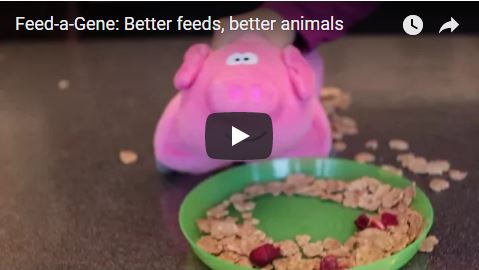Feed-a-Gene News - January 2018
Editorial by project coordinator Jaap van Milgen
Dear readers,
First, I would like to wish you all the best for 2018 in your professional and personal life. Try to stay healthy and happy; the New Year should bring us plenty of challenging opportunities.
After the first two annual newsletters, sent out in 2016 and 2017, I am pleased to introduce this second Feed-a-Gene intermediate news bulletin. Because the number of project results will increase during the last two years of the project, we plan to publish newsletters more frequently so that you can become aware of these project results and use them in your day-to-day business.
Please have a look at the videos published on the Feed-a-Gene YouTube channel. You will find several videos of researchers talking about their role in the project, and more videos will be published in the next weeks. We also created a funny video, "Better feeds, better animals" in which we explain the objectives and activities of the Feed-a-Gene project to a broad audience. This video is part of a competition set out by the European Commission to increase public awareness of H2020 projects. We participate in this competition where the winner is determined by the number of “likes”. If you like it (and I am sure you do), please click on the “thumbs up” button on YouTube.
2017 last achievements: peer-reviewed papers and communications
A lot has happened in the last quarter of 2017. Two peer-reviewed papers were accepted and published:
- October 2017: Genetic structured antedependence and random regression models applied to the longitudinal feed conversion ratio in growing Large White pigs by Huynh-Tran et al., 2017, in the Journal of Animal Science
- December 2017: Genetic parameters and expected responses to selection for components of feed efficiency in a Duroc pig line by Sanchez et al., 2017, in Genetics Selection Evolution
Both articles are downloadable and present some of the results of the fruitful WP5 Use of traits in animal selection.
4 communications were presented between September and November 2017:
- Emma Fabrega (IRTA): New physiological indicators for welfare assessement: Cromogranin A (11th IVBM International Veterinary Behaviour Meeting, 14-16 September 2017, Samorin, Slovakia )
- Nathalie Quiniou (INRA): Assessment of the dynamic growth of the fattening pigs from body weight measured daily and automatically to elaborate precision feeding strategies (8th EC-PLF European Conference on Precision Livestock Farming 2017, 12-14 September, Nantes, France)
- Ludovic Brossard (INRA): Selection of methods to analyze body weight and feed intake data used as inputs for nutritional models and precision feeding in pigs (EC-PLF)
- Galyna Dukhta (Kaposvár University): A growth model to predict body weight and body composition of broilers (A jövo tudósai, a vidék jövoje - Future scientists, Future countryside, Doctoral Conference, 24 November 2017, Debrecen University, Debrecen, Hungary)
In addition, project coordinator Jaap van Milgen presented Feed-a-Gene at the "Climate and Environmental Sustainability" session held at the FOOD2030 conference of the European Commission, on 16 October 2017. During this presentation he discussed feed efficiency and the role of livestock in sustainable food production. The video of the presentation is available here.
Next in 2018!
2 scientific papers have been submitted for peer review.
Feed-a-Gene researchers have already planned 7 presentations for the next 2 months:
- Hervé Garreau, Hélène Gilbert, Loys Bodin (INRA), Mostafa Helal and Juan Pablo Sanchez (IRTA) will present no less than 5 communications at the next WCGALP (World Congress on Genetics Applied to Livestock Production), 11-16 February, Auckland, New Zealand
- Lisanne Verschuren (Topigs) will present 2 communications at the following meetings:
- WIAS Science Day 2018, Work on your Impact in Animal Sciences and Society, 5 Feburary 2018, Wageningen, The Netherlands
- AASV (American Association of Swine Veterinarians) annual meeting, 2-6 March 2018, San Diego, California, USA
All materials will be published on the website when they become available.




